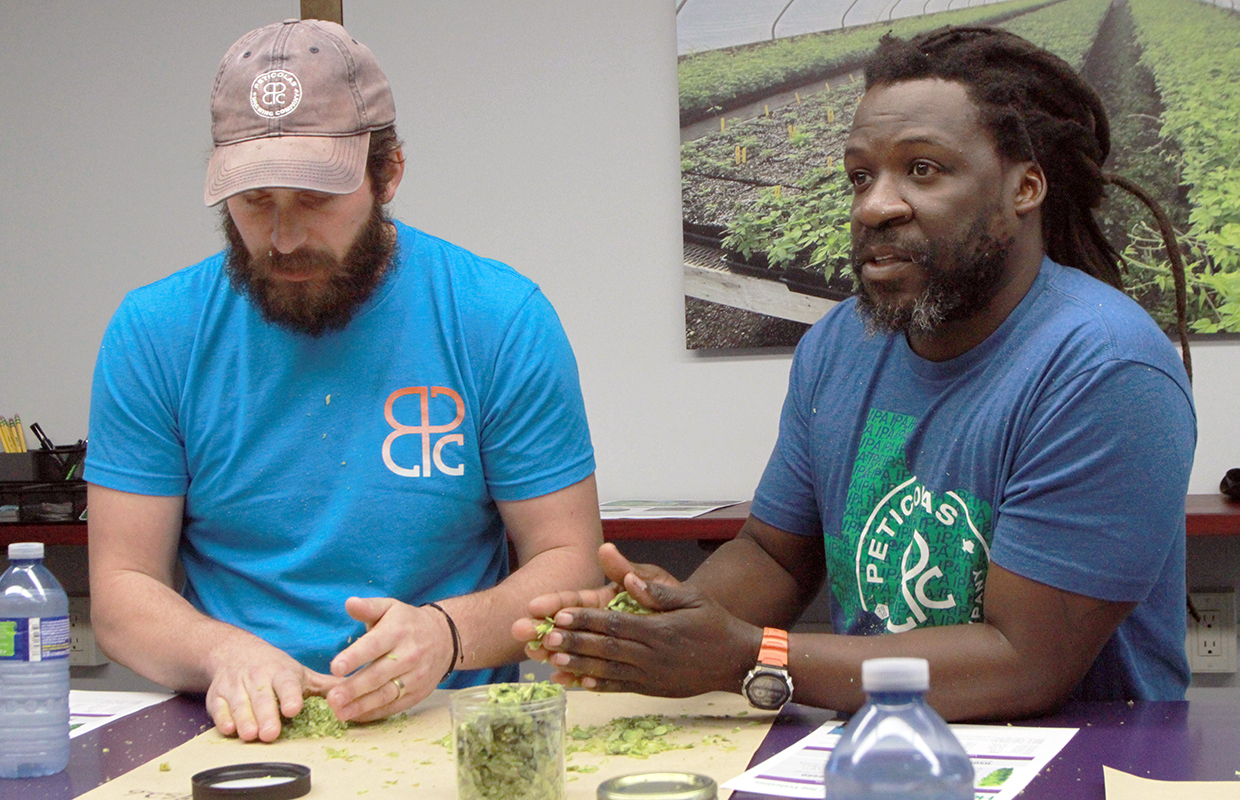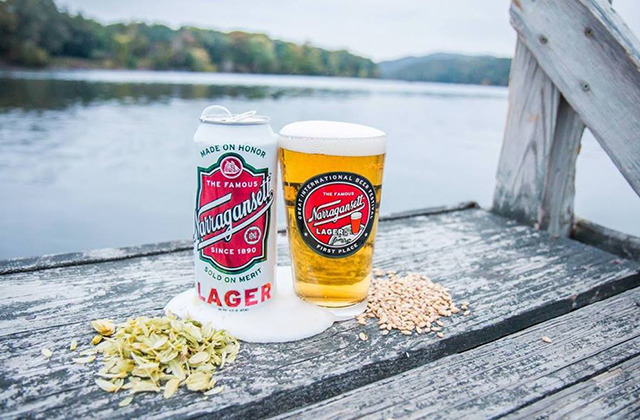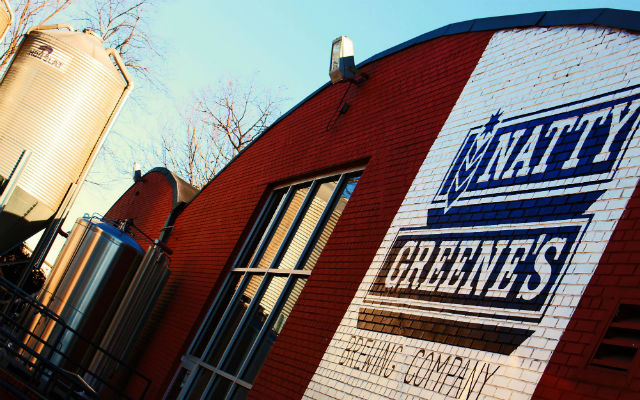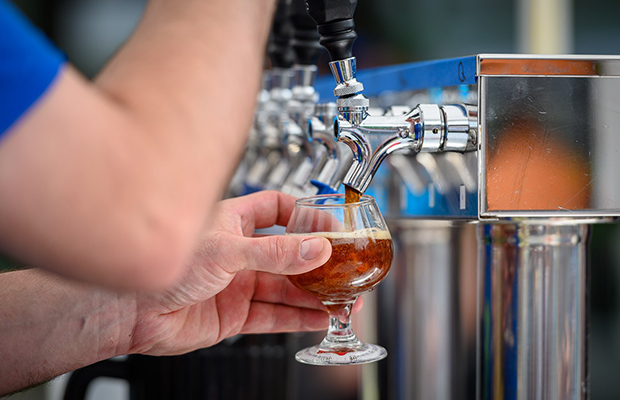
Not every brewer gets a chance to step into the room, but it’s an important room that can better your beer. Thanks to Hopsteiner, Brewer had the chance to step into a hop vendor selection room to rub different hops lots with breweries from across the country this fall for hop harvest in Yakima, Washington. It was a chance to gain insights on why hop sensory is important, share tips on how to find the right hops and help lead a positive direction in creating better beer.
“To me, there seems like an obvious quality benefit,” said first-time attendee Mike Beebe, who just recently took over as Head Brewer for Firehouse Brewing. He is starting to make adjustments to the Rapid City, South Dakota’s core lineup, and having a hand in selecting hop contracts is another key step forward for the company.
“The fact that my brewery was in a position to send me out for this trip and to learn more about a huge aspect of the industry, see the hops in their pre-pelletized state, and doing samples off bales; there’s a lot of advantages there. It’s kind of a next-level thing to get to do, he said.”
Hopsteiner sales reps like Steve Bradt took brewers like Beebe through the hop selection process in a room located right near the processing plant. Each room, cleaned between uses to avoid lingering smells of other hops, provides brewers with a fresh space for as in-depth analysis as they desire. They are provided in depth information on the different lots to assist brewers in categorizing hops for their specific brands.
Jarrod Asberry at Dallas’ Peticolas Brewing was on his second trip to Hopsteiner for hop selection and along with fellow brewer, Jacob Longoria, they were rubbing through five different lots of Cascade, an important hop for daily production.
“Once I realized that the lots can be different, I know that it makes a total difference in how each lot can be,” Asberry said of why going through those lots is important. “You don’t really want to take a flier, right? You know exactly what you get and know what you are putting in your beer.
“Once you realize the same hop can be different for different areas, you might as well choose the best one that you can. It’s like going shopping at the meat market. This is choice, this is prime.”
Some brewers that the staff of Brewer observed moved around the table, taking handfuls of core samples and rubbing in a variety of ways to extract the aroma. Some, like Free State veteran Geoff Deman, had a notepad and took immediate notes as he was doing rubs.
“I’ve definitely been a brewer that is more on feel. I’m not as heavily into the scientific. I certainly follow all that, but a lot of it is on instinct,” he said. “Generally speaking, your first impression is the strongest impression, and I think it’s the most important impression.”
It’s similar to judging beer, which Deman had just finished up the week before at the Great American Beer Festival in Denver.
“I’m taking notes of how things look, but oddly enough, there are times where the hop looks bad and it smells way better than the others,” Deman said. “I might make notes of the appearance, whether or not there’s a lot of signs of disease, wind burn. Is there a high seed content, there generally isn’t.
“The color as well, but doing all that, really the most important thing is the aroma. It’s the closest thing that translates into what we see and what we experience, and we hope that once it’s pelletized, it’s the same.”
Bradt, who used to work at Free State as a brewer himself before joining Hopsteiner, was only as involved audibly as the brewer he was working with needed. He was there to answer questions, but never tried to give his own opinion. He stressed it was their call what they wanted out of the rubs.
“We could set the same five lots in front of someone else in the last room, and they will be different numbers,” he explained. “They are set so the customer has some coded number, and then that number is coded into our system to our grower numbers.
“We can provide information on which field, which grower and where they came from. We generally don’t, as a matter of course. But if it’s something that people feel is really important then we can generate that information.”
For Josh Rein, the Head Brewer at Logboat in Columbia, Missouri, having a relationship with a sales rep and having them know something about each brewery’s beer is a big help.
“Anyone enthusiastic about what they got going on with raw material processing, I find to be a super exciting situation,” he said. “It makes it fun. I don’t feel like I’m being sold things. Opportunities like this to come and have a selection of the various crops that we want and having that control over our product is awesome. And then getting access to some experimental things is a really great thing as well.”
Rein said that the brewery’s core IPA, Snapper, turned into something that they really enjoyed more than they ever did once they began to hand-pick hops.
“Choosing those hops is something that is a huge thing for us as far as control of the product,” he said. “That was a real eye-opener. We had to get to enough of a volume produced to really make sense for us to be able to have the investment into making the selection.”
Generally, a hop contract is something a brewery would want to look at if they are using more than 220 pounds of a certain hop in a year. For Logboat, Rein said the brewery went to their first hop selection in 2019 and returned for the first time since to pick from a lot of Helios as a bittering addition.
Once that was picked out, three different hops were poured through as well, all with experimental names still — including 93206, 16660 — with 17701 about to get a brand name for use after its popularity over the last few years of growing (Editor’s Note: Hopsteiner announced the name as Alora in December, 2023). Each brewer is given a chance to visit the experimental fields and see what the potential future of hops entails along with a chat with Nicholi Pitra, Lead Scientist of Variety Development and Bioinformatics at Hopsteiner..
“I’m gonna definitely try to brew with this,” Asberry said about Alora, “People are gonna be saying Citra what?! That’s probably one of the favorites of the day. I would go with an intense IPA west coast.”
Along with rubbing hops and getting tours of the farms, brewers get a chance to sit down and try some fresh hop beers made locally as Hopsteiner hosted a dinner at the end of the evening. Collaboration is a big byproduct of these meals and many future fresh hop beers will get planned while brewers from across the country get to meet up and talk.
Something like CBC can be so big, Bradt said, you just can’t have many personal chats anymore.
“I feel like this here is a little microcosm of that,” he said. “You do get a chance to get together with a manageable number of brewers, socialize a bit, do something that you’re all passionate about, talk through all that stuff. There’s not that many places in the industry to have that interaction, and have it with people from all over the country, not just your neighborhood.”
Yakima in September is a special place, Deman said.
“It’s a very special agricultural product area,” he said. “This entire valley is full of those, it’s really interesting just to drive through the valley, let alone go do hop selection.
“I brewed in Seattle for years and didn’t come to Yakima once. It just wasn’t part of the culture back then. And I really regret that we didn’t do that.”
Two keys to getting ready for a hop selection trip after you have had the chance to be invited is to make sure you have your sensory planned out.
“Unless you have enough reps doing those processes, where you’re not necessarily going to be able to pick out a lot of specific components, or you haven’t developed the vocabulary to do it, I’m not sure really how helpful it’s going to be for someone,” Deman said. “It’s one thing to say, I like this or I don’t like this, but it’s more important to give it a shape to those characteristics.
“Go in with certain notions of what you want your varietals to be, but also be able to go into it a little bit blind and make solid enough identifications of characteristics that are going to show up. That’s for any of your ingredients.”
The final tip Deman said, jokingly?
“All your clothes may smell bad,” he said and laughed. “You smell like stinky, cheesy … it’s really bad. It’s nice if your AirBnB or whatever has a washing machine.
“I have gone to the Lost Sock (a laundromat in Yakima) before and washed my clothes, because yeah, I don’t want to be that guy on the plane that smells like that.”






3 Trackbacks / Pingbacks